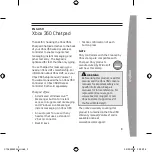
48VFL & 96VFL v1.2 07/13
A1MD/A2MD DESCRIPTION
Normal alarm mode/ When timer function is selected, with the PV<SV,
the timer function is disabled
Standby mode When selected, in any alarm function, an alarm on
power-up is prevented. The alarm is enabled only when the process
value reaches the alarm set point. Also known as “Startup inhibit”
(useful for avoiding alarm trips during startup)
Latch mode. When selected, the alarm output and indicator “latch”
when the alarm occurs. The alarm output and indicator will remain
energized even if the alarm condition has been cleared (unless the
power to the meter is removed)
Standby and latch mode
■
AUTOMATIC AND MANUAL OUTPUT CONTROL
Automatic control is the normal mode of controller operation. In automatic control mode
the controller automatically adjusts the control output percentage, using PID, to bring the
PV equal to the SV. The PID parameters Pb, Ti and Td can be automatically determine
using the Auto Tune procedure.
Manual control allows the user to manually drive the output percentage from 0.0 to
100.0%. To access the manual mode, set the “
”parameter to “
”, the right-most
decimal (MA) on the SV display will flash. The “
” parameter will then alternately
display
and the process value. The output percentage can then be adjusted using
the UP or DOWN keys. To abort the manual control, simply set “
” to “
”.
■
AUTO TUNE
In order to automatically set the PID parameters in the PID level (“Pb” proportional band,
“ti: integral time, also known as ‘reset’, and “td” derivative time, also known as ‘rate’), first
adjust the controller’s set point to a value that closely approximates the application at
hand. Set the “
” parameter to “
” for standard applications or “
” for
minimizing SV overshoot (see diagram below). The right-most decimal point (AT) on the
PV display will flash in Auto Tune mode. This procedure will run two cycle oscillations.
After that, the controller performs PID control with the “learned” PID value to verify the
results. Finally the PID values will be entered into the nonvolatile memory and then starts
the Fuzzy enhanced PID control. The auto tune process can last from several minutes up
to two hours, depending on the process in question. A time out error will occur if the auto
tune process can not be completed within two hours, in this case, try to set the PID
parameters manually. To abort an auto tune process, simply set the “
” parameter to
“
”.
www.
.com
1.800.561.8187































